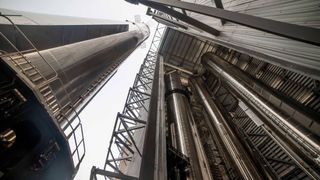
We're likely still a month or so away from the next launch of SpaceX's Starship megarocket.
That was the timeline Elon Musk offered in a post on X over the weekend, saying Starship's next test flight is "probably 3 to 5 weeks" away. "Objective is for the ship to get past max heating, or at least further than last time," the billionaire entrepreneur added.
The 400-foot-tall (122 meters) Starship is the biggest and most powerful rocket ever built. It consists of two elements, both of which are designed to be fully and rapidly reusable: a huge first-stage booster called Super Heavy and a 165-foot-tall (50 m) upper stage known as Starship, or simply "Ship."
Related: Relive SpaceX Starship's 3rd flight test in breathtaking photos

A fully stacked Starship has flown three times to date, on each occasion from SpaceX's Starbase site in South Texas — in April 2023, November 2023 and March 14 of this year. The giant vehicle has performed better with each successive flight.
During the debut liftoff, for example, Starship's two stages failed to separate as planned, and SpaceX detonated the tumbling vehicle just four minutes after liftoff. Flight 2 achieved stage separation, but both Super Heavy and Ship broke apart early, ending the mission after eight minutes.
On Flight 3, Super Heavy successfully steered its way into position for a planned Gulf of Mexico splashdown but broke apart about 1,650 feet (500 m) above the waves. Ship reached orbital velocity and flew for nearly 50 minutes, though it ultimately succumbed to the violent forces of frictional heating when reentering Earth's atmosphere.
Get the Space.com Newsletter
Breaking space news, the latest updates on rocket launches, skywatching events and more!
As he noted in his X post, Musk wants Ship to do even better on the upcoming Flight 4.
SpaceX has been gearing up for Flight 4 for a while now. The company has already conducted static fire tests for both the Super Heavy and the Ship assigned to the mission, briefly igniting their Raptor engines while the vehicles remained anchored to the pad at Starbase. SpaceX also recently rolled Flight 4's Super Heavy back to the pad, presumably for more testing, a move the company chronicled in a post on X on Saturday (May 11).
However, there may still be logistical hurdles to clear; SpaceX is seeking a license modification for its next launch from the Federal Aviation Administration, which is overseeing an investigation into what happened on the March 14 flight.
Editor's note: The original version of this story incorrectly stated that SpaceX is seeking a launch license from the FAA for the next Starship liftoff. SpaceX already has a launch license; it is seeking a modification of that license. The story was corrected at 11:15 a.m. ET on May 14 to make this clear.
Join our Space Forums to keep talking space on the latest missions, night sky and more! And if you have a news tip, correction or comment, let us know at: community@space.com.

Michael Wall is a Senior Space Writer with Space.com and joined the team in 2010. He primarily covers exoplanets, spaceflight and military space, but has been known to dabble in the space art beat. His book about the search for alien life, "Out There," was published on Nov. 13, 2018. Before becoming a science writer, Michael worked as a herpetologist and wildlife biologist. He has a Ph.D. in evolutionary biology from the University of Sydney, Australia, a bachelor's degree from the University of Arizona, and a graduate certificate in science writing from the University of California, Santa Cruz. To find out what his latest project is, you can follow Michael on Twitter.
-
Rob77 Admit a little disappointed at the delay, I'm sure month ago they were eyeing early May?Reply
But I guess its to be expected. It looked like they were getting another ready, maybe they might try 2 test runs consecutively? -
danR Translation: 6 to 10 weeks.Reply
From the days of Starhopper I'd been anticipating a gradual shift from linear cadence progress to exponential. That has been happening, but the exponent isn't very great, and isn't getting greater at any rate commensurate with getting manned missions to the Moon in under 4 years, or to Mars before 2035. -
Classical Motion Putting a man on Mars is no problem. Getting him back is. You will have to send and build an oasis before you can send a man. And you will need gravity and shielding for the trip.Reply
2035-------maybe cockroaches. A man would only demonstrate ego over reason. Hollywood over reality.
PR taken too far. What is the true value in going? Who benefits from the cost, time and resources?
There is nothing new there. Send probes to our outer edge, out beyond Pluto and farther for newness. Analyze the corrosion of our system.
We have recently found debris fields for all the planets. Perhaps our system leaves such.